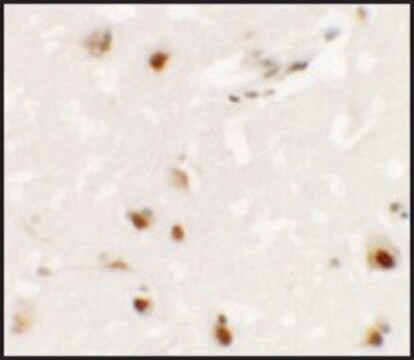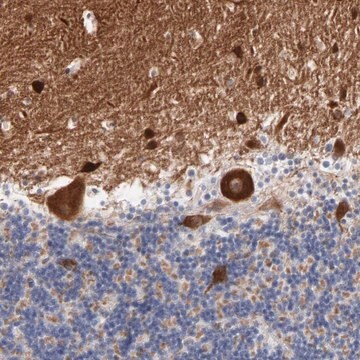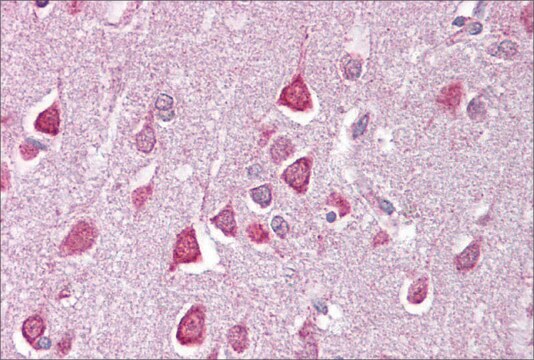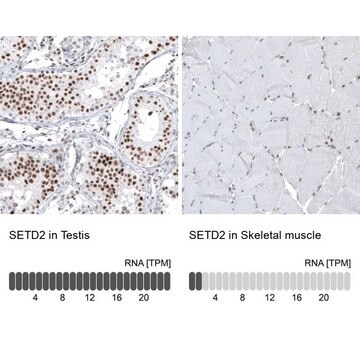推荐产品
生物源
mouse
品質等級
抗體表格
purified antibody
抗體產品種類
primary antibodies
無性繁殖
16E2.3, monoclonal
物種活性
mouse
物種活性(以同源性預測)
human (based on 100% sequence homology)
技術
western blot: suitable
同型
IgG2aκ
NCBI登錄號
UniProt登錄號
運輸包裝
wet ice
目標翻譯後修改
unmodified
基因資訊
human ... SHANK3(85358)
一般說明
SH3 and multiple ankyrin repeat domains protein 3 (UniProt Q9BYB0; also known as Proline rich synapse associated protein 2, ProSAP2, Shank postsynaptic density protein, Shank3) is encoded by the SHANK3 (also known as DEL22q13.3, PROSAP2, PSAP2, SCZD15, SPANK-2) gene (Gene ID 85358) in human. Shank3/ProSAP2 belongs to the ProSAP/Shank family of scaffolding proteins, which are important dendritic spines postsynaptic density (PSD) complex components that play an important role in linking membrane glutamate receptors to intracellular signaling proteins and actin cytoskeleton. Shank proteins interact with adaptor proteins and assembles glutamate receptors at the postsynaptic membrane via multiple domains, including ankyrin repeat, proline-rich, SH3, PSD95/disc-large/zona occludens-1 (PDZ), and SAM domains. Shanks, together with the adaptor protein Homer and the endocytic vesicle-associated protein dynamin-3, are required for proper localization of the endocytic zone in close proximity to the PSD. Shank-3 induces formation of functional dendritic spines in aspiny cerebellar neurons, whereas Shank-3 knockdown results in reduced spine density and size in cultured hippocampal neurons. SHANK3 gene mutations are known causes of mental retardation and autism spectrum disorders.
特異性
Expected to react with both isoform 1 (A) and 2 (B).
免疫原
Epitope: Internal (C-terminal half)
GST-tagged recombinant protein corresponding to the C-terminal half of human Shank3.
應用
Research Category
Neuroscience
Neuroscience
Research Sub Category
Developmental Signaling
Developmental Signaling
This Anti-Shank3 Antibody, clone 16E2.3 is validated for use in Western Blotting for the detection of Shank3.
品質
Evaluated by Western Blotting in mouse brain tissue lysate.
Western Blotting Analysis: 0.2 µg/mL of this antibody detected Shank3 in 10 µg of mouse brain tissue lysate.
Western Blotting Analysis: 0.2 µg/mL of this antibody detected Shank3 in 10 µg of mouse brain tissue lysate.
標靶描述
~185 kDa observed. Multiplet banding pattern as a result of isoforms and/or posttranslational modifications. Uncharacterized band(s) may appear in some lysates.
外觀
Protein G Purified
Format: Purified
Purified mouse monoclonal IgG2aκ antibody in buffer containing 0.1 M Tris-Glycine (pH 7.4), 150 mM NaCl with 0.05% sodium azide.
儲存和穩定性
Stable for 1 year at 2-8°C from date of receipt.
其他說明
Concentration: Please refer to lot specific datasheet.
免責聲明
Unless otherwise stated in our catalog or other company documentation accompanying the product(s), our products are intended for research use only and are not to be used for any other purpose, which includes but is not limited to, unauthorized commercial uses, in vitro diagnostic uses, ex vivo or in vivo therapeutic uses or any type of consumption or application to humans or animals.
未找到合适的产品?
试试我们的产品选型工具.
儲存類別代碼
12 - Non Combustible Liquids
水污染物質分類(WGK)
WGK 1
閃點(°F)
Not applicable
閃點(°C)
Not applicable
我们的科学家团队拥有各种研究领域经验,包括生命科学、材料科学、化学合成、色谱、分析及许多其他领域.
联系技术服务部门







